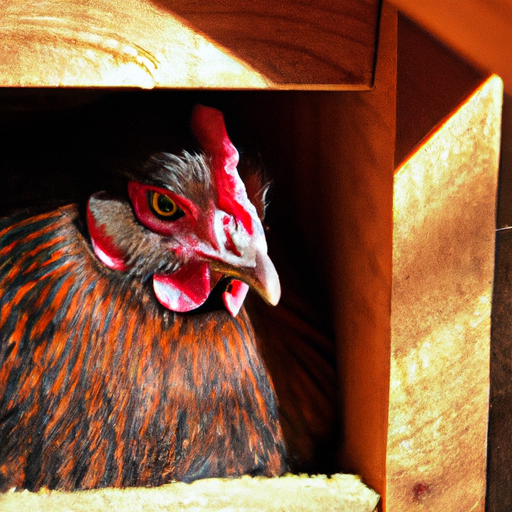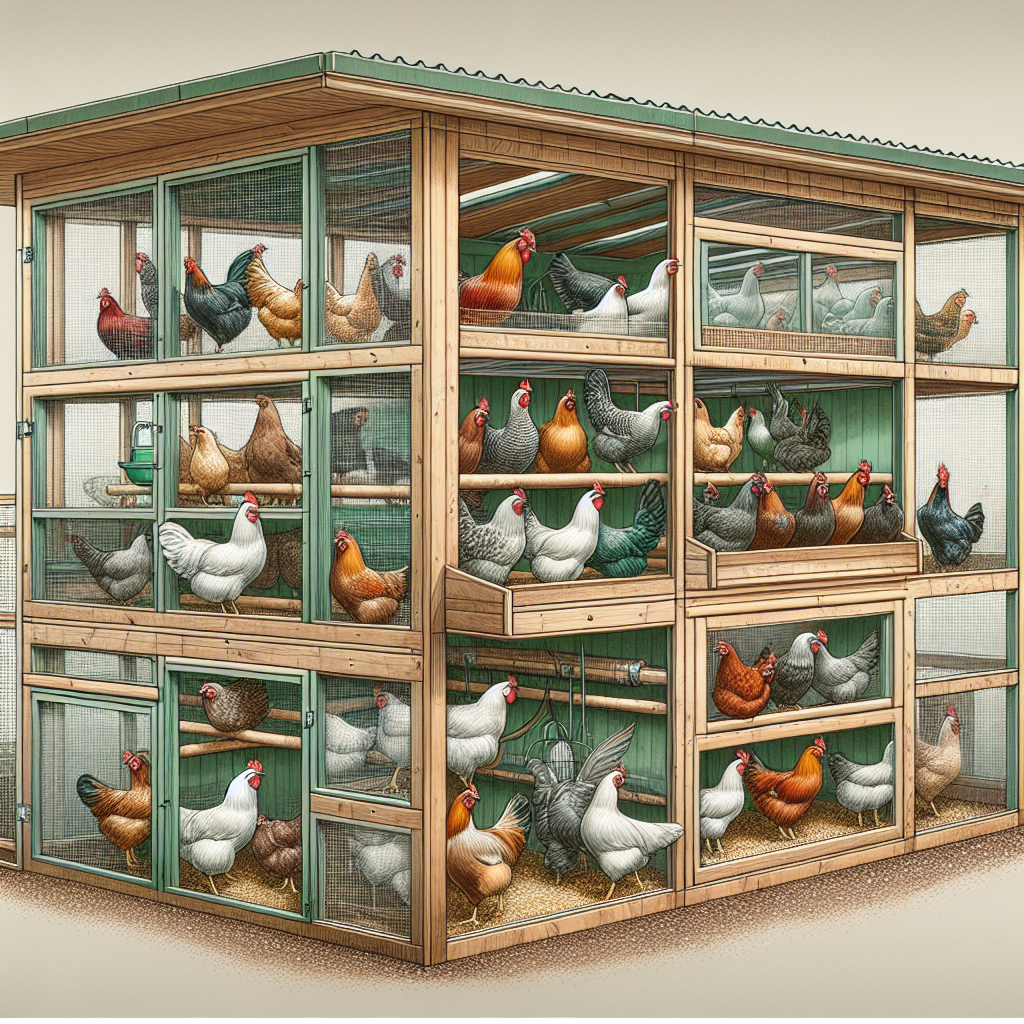If you’re contemplating raising chickens in your backyard but have concerns about how they’ll fare in your specific climate or weather conditions, you’ve come to the right place. In this article, we’ll explore whether certain coop varieties are better adapted to thrive in specific climates or weather conditions. Whether you live in a hot and humid region, a cold and snowy one, or somewhere in between, we’ll uncover the best coop varieties to ensure your feathered friends are comfortable and happy all year round. So let’s dive in and discover the coop options that will suit your climate like a cozy nest! Yes, there are coop varieties that are particularly suited for specific climates or weather conditions. When it comes to raising chickens, it’s important to create an environment that is comfortable and safe for them. Factors such as temperature, humidity, wind, and precipitation can have a significant impact on the well-being of your flock. By understanding the needs of your chickens and the climate in which you live, you can choose the right coop variety that will provide optimal conditions for your feathered friends.
Coop Varieties for Hot Climate
If you live in a hot climate, it’s important to choose chicken breeds that can tolerate high temperatures. Some heat-tolerant breeds include the Leghorn, Sussex, and Orpington. These breeds are known for their ability to withstand hot weather and continue to lay eggs.
When it comes to coop design, there are a few key factors to consider. Providing shade and ventilation is crucial in hot climates. Make sure your coop has a covered area where chickens can escape the direct sun. You can also add additional shade structures, such as awnings or umbrellas, to protect your chickens from excessive heat.
Ventilation is another important aspect of coop design in hot climates. Make sure your coop has plenty of windows or vents to allow for air circulation. You can also install fans or misters to help cool down the coop during the hottest parts of the day.
Lastly, consider implementing watering and cooling systems in your coop. Providing fresh, cool water is essential for keeping your chickens hydrated in hot weather. You can also install misting systems or wetting down the ground around the coop to help lower the ambient temperature.
Coop Varieties for Cold Climate
In cold climates, it’s important to choose chicken breeds that are cold-hardy. Some breeds that do well in cold weather include the Rhode Island Red, Plymouth Rock, and Wyandotte. These breeds have thick feathers and can withstand freezing temperatures.
When it comes to coop design, insulation is key. Make sure your coop is well-insulated to keep your chickens warm during the cold winter months. You can use materials such as foam board or straw bales to provide extra insulation.
Heating options can also be considered in extremely cold climates. While chickens have their own natural body heat to keep them warm, you can provide additional heat sources like heat lamps or heated perches to help them stay cozy.
Winterizing the coop is another important step in cold climates. This includes sealing any drafts, insulating water containers, and providing extra bedding for your chickens to nestle in.
Coop Varieties for Humid Climate
In humid climates, it’s important to choose chicken breeds that are resistant to humidity. Breeds such as the Australorp, Delaware, and Ancona tend to do well in these conditions.
Ventilation and air circulation are crucial in humid climates to prevent moisture buildup in the coop. Make sure your coop has plenty of windows and vents to allow for proper airflow. You can also install fans or use natural breezes to help keep the coop well-ventilated.
Preventing mold and fungal growth is another consideration in humid climates. Make sure to regularly clean and disinfect your coop to prevent the buildup of moisture-loving organisms. Using absorbent bedding materials, such as pine shavings or straw, can also help keep the coop dry.
Humidity control measures can also be implemented in humid climates. This can include installing dehumidifiers or using moisture-absorbing materials in the coop.
Coop Varieties for Dry Climate
In dry climates, it’s important to choose chicken breeds that are drought-resistant. Breeds such as the Sussex, Cochin, and Brahmas have been known to do well in dry conditions.
Dust control and prevention are important in dry climates. Dry and dusty conditions can lead to respiratory issues in chickens. Use materials such as sand or gravel in the run area to minimize dust. Regularly wetting down the ground can also help prevent excessive dust.
Water conservation strategies can also be implemented in dry climates. This includes using water-saving devices such as nipple waterers or drip irrigation systems. Collecting and reusing rainwater can also help conserve water.
Protection from extreme heat is crucial in dry climates. Providing shade structures, such as awnings or shade cloth, can help keep your chickens cool during hot weather. Adding extra ventilation, such as fans or windows, can also help regulate the temperature in the coop.
Coop Varieties for Coastal Climate
If you live in a coastal climate, it’s important to choose chicken breeds that are salt-resistant. Breeds such as the Sussex, Rhode Island Red, and Aracauna tend to do well in these conditions.
Structural considerations for coastal areas are important due to the salt-laden air. Make sure your coop is made of materials that are resistant to corrosion, such as aluminum or PVC. Regularly washing down the coop with fresh water can also help remove any salt buildup.
Protection from sea breezes and storms is important in coastal climates. Make sure your coop is well-anchored to withstand strong winds. Providing windbreaks, such as solid walls or planting wind-resistant vegetation, can also help protect your chickens from the elements.
Maintenance tips for coastal coops include regularly checking for any signs of rust or corrosion and promptly addressing any issues. It’s also important to regularly clean and disinfect the coop to prevent the buildup of salt and other debris.
Coop Varieties for Mountainous Climate
If you live in a mountainous climate, it’s important to choose chicken breeds that are adaptable to high altitude. Breeds such as the Chantecler, Naked Neck, and Rhode Island Red tend to do well at higher elevations.
Wind and weatherproof coop design is crucial in mountainous climates. Make sure your coop is well-built and able to withstand strong winds and heavy snowfall. A sturdy roof and strong walls are essential in these conditions.
Insulation against cold and wind is another important consideration in mountainous climates. Make sure your coop is well-insulated to help keep the chickens warm during cold weather. Adding extra bedding and providing nesting boxes with deep straw can also help keep your flock cozy.
Security against predators is crucial in mountainous areas. Make sure your coop is predator-proof, with strong doors and windows. Fortify the coop with sturdy wire mesh and bury wire mesh underground to prevent digging predators.
Coop Varieties for Tropical Climate
In tropical climates, it’s important to choose chicken breeds that are well-suited to the heat and humidity. Breeds such as the Malay, Sumatra, and Asil tend to do well in these conditions.
Natural pest control in the coop is important in tropical climates. Chickens are natural insect hunters and will enjoy foraging for insects in the coop. Providing ample space for the chickens to roam and access to natural vegetation can help encourage this behavior.
Shade and ventilation are important considerations in tropical climates. Make sure your coop has plenty of shade structures, such as awnings or trees, to help protect your chickens from the direct sun. Proper ventilation, such as windows, vents, and fans, can also help regulate the temperature and prevent the buildup of moisture.
Managing high humidity and rainfall is crucial in tropical climates. Regularly cleaning and disinfecting the coop can help prevent the growth of mold and other moisture-loving organisms. Providing absorbent bedding materials, such as sawdust or wood shavings, can help keep the coop dry.
Coop Varieties for Arid Climate
If you live in an arid climate, it’s important to choose chicken breeds that are water-efficient. Breeds such as the Leghorn, Minorca, and Spanish are known for their ability to thrive with limited water.
Shade and insulation from heat are important in arid climates. Make sure your coop has shaded areas where chickens can escape the direct sun. You can use materials such as shade cloth or trees to provide additional shade. Insulating the coop with materials such as foam board or straw bales can also help regulate the temperature.
Dust control and prevention are important in arid climates to prevent respiratory issues in chickens. Use materials such as sand or gravel in the run area to minimize dust. Regularly wetting down the ground can also help prevent excessive dust.
Managing limited vegetation is another consideration in arid climates. Providing access to natural vegetation or planting drought-resistant plants can help supplement the chickens’ diet when foraging for food.
Coop Varieties for Rainy Climate
In rainy climates, it’s important to choose chicken breeds that are resistant to wet conditions. Breeds such as the Marans, Java, and Orpington tend to do well in these conditions.
Waterproofing the coop is crucial in rainy climates. Make sure your coop is well-sealed to prevent water from seeping in. Use materials such as silicone caulking or waterproof paint on the coop’s walls and roof. Providing an elevated platform for the chickens to roost on can also help keep them dry.
Drainage and flood prevention are important considerations in rainy climates. Make sure your coop is located on higher ground and has proper drainage to prevent flooding. You can also install gutters and downspouts to divert water away from the coop.
Mud control in the run area is another important aspect in rainy climates. Providing a well-drained area, such as a gravel or sand base, can help minimize mud and make it easier to clean. Regularly adding fresh bedding and removing any wet or soiled materials can also help keep the coop clean.
Coop Varieties for Windy Climate
If you live in a windy climate, it’s important to choose chicken breeds that are wind-resistant. Breeds such as the Brahma, Sussex, and Cochin tend to do well in these conditions.
Coop orientation and windbreaks are crucial in windy climates. Make sure your coop is facing away from prevailing winds to minimize exposure. Planting wind-resistant vegetation, such as hedges or trees, can also help create natural windbreaks.
Securing the coop and run is important in windy areas. Make sure your coop is well-anchored to prevent it from being blown over by strong winds. Reinforce the coop with additional bolts or screws if necessary. Use strong wire mesh or fencing to enclose the run area and protect your chickens from flying debris.
Protection from flying debris is another consideration in windy climates. Make sure your coop has a strong roof and walls to prevent damage from windborne objects. Regularly inspect the coop for any signs of wear or damage and promptly repair any issues.
By considering these coop varieties for different climates, you can create a comfortable and safe environment for your chickens. Remember to choose chicken breeds that are well-suited to your specific climate and take into account factors such as temperature, humidity, wind, and precipitation. With the right coop design and management practices, your flock can thrive in any climate or weather condition.




